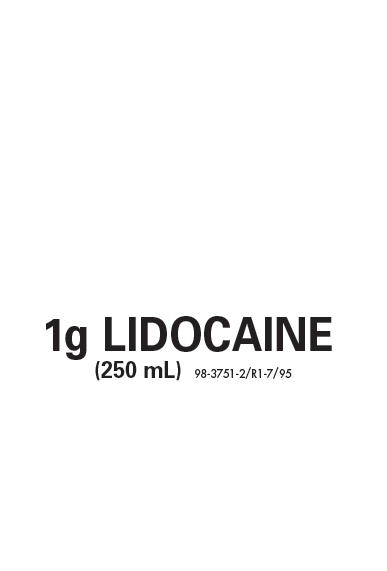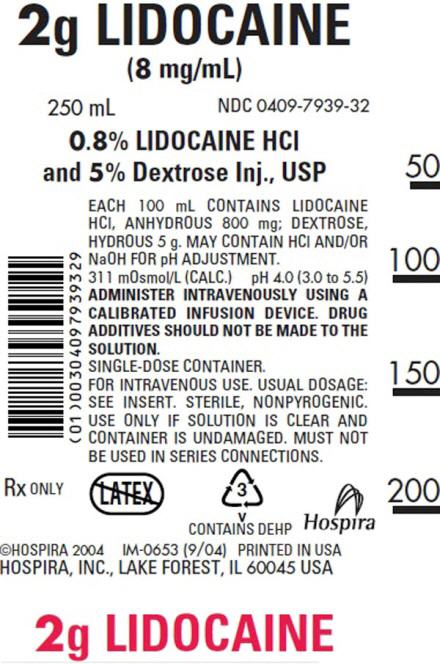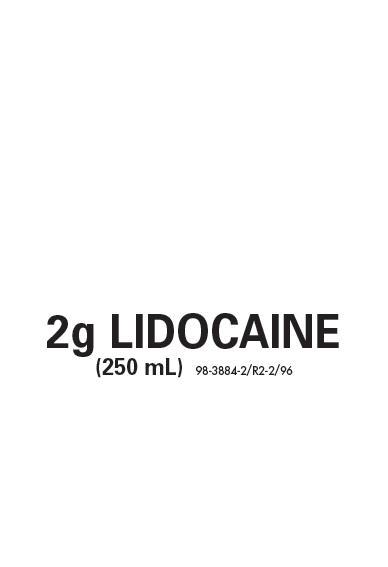LIDOCAINE HYDROCHLORIDE AND DEXTROSE- lidocaine hydrochloride injection, solution
Hospira, Inc.
----------
0.4% and 0.8% LIDOCAINE HYDROCHLORIDE
and 5% DEXTROSE INJECTION, USP
AQUEOUS SOLUTIONS FOR ACUTE MANAGEMENT OF CARDIAC ARRHYTHMIAS
Flexible Plastic Container Rx only
Do not admix with other drugs
DESCRIPTION
0.4% and 0.8% Lidocaine Hydrochloride and 5% Dextrose Injection, USP are sterile, nonpyrogenic solutions of lidocaine hydrochloride and 5% Dextrose Injection, USP for use in the management of ventricular arrhythmias.
Each 100 mL contains lidocaine hydrochloride, anhydrous 400 mg (4 mg/mL) or 800 mg (8 mg/mL) and dextrose hydrous 5 g in water for injection. The osmolarity of the solutions is 282 and 311 mOsmol/liter (calc.) respectively. May contain hydrochloric acid and/or sodium hydroxide for pH adjustment. pH 4.0 (3.0 – 5.5).
The solution contains no bacteriostatic, antimicrobial agent or added buffer (except for pH adjustment) and is intended only for use as a single-dose administration. When smaller doses are required, the unused portion should be discarded.
Lidocaine administered intravenously is a cardiac antiarrhythmic agent.
Lidocaine Hydrochloride, USP is chemically designated 2(diethylamino)2', 6'-acetoxylidide monohydrochloride monohydrate, a white powder freely soluble in water. It has the following structural formula:
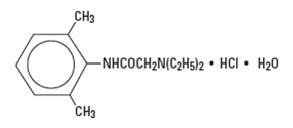
Dextrose, USP is chemically designated D-glucose monohydrate (C6H12O6•H2O), a hexose sugar freely soluble in water. It has the following structural formula:

Water for Injection, USP is chemically designated H2O.
The flexible plastic container is fabricated from a specially formulated polyvinylchloride. Water can permeate from inside the container into the overwrap but not in amounts sufficient to affect the solution significantly. Solutions inside the plastic container also can leach out certain of its chemical components in very small amounts before the expiration period is attained. However, the safety of the plastic has been confirmed by tests in animals according to USP biological standards for plastic containers.
CLINICAL PHARMACOLOGY
Lidocaine hydrochloride exerts an antiarrhythmic effect by increasing the electric stimulation threshold of the ventricle during diastole. In usual therapeutic doses, lidocaine hydrochloride produces no change in myocardial contractility, in systemic arterial pressure, or in absolute refractory period.
About 90% of an administered dose of the drug is metabolized in the liver. The remaining 10% is excreted unchanged via the kidneys.
Lidocaine toxicity is related to systemic blood levels. The decreased clearance and longer half-life of lidocaine should be taken into consideration with prolonged (24 hour) infusions. Constant rate of infusion may result in toxic accumulation of lidocaine. Infusion should be reduced to approximately one-half to compensate for decreased rate of clearance and concomitant or prior administration of propranolol may further increase blood concentrations by as much as 30% in patients without cardiac or hepatic failure. In clinical studies, patients over 65 years showed decreased lidocaine clearance. This was partly due to the tendency of elderly patients to have lower body weight and the increased risk of cardiac failure in these patients.
This solution provides approximately 170 calories per liter.
INDICATIONS AND USAGE
Lidocaine hydrochloride administered intravenously is specifically indicated in the acute management of (1) ventricular arrhythmias occurring during cardiac manipulations, such as cardiac surgery and (2) life-threatening arrhythmias which are ventricular in origin, such as occur during acute myocardial infarction.
CONTRAINDICATIONS
Lidocaine hydrochloride is contraindicated in patients with a known history of hypersensitivity to local anesthetics of the amide type.
Lidocaine should not be used in patients with Stokes-Adams syndrome, Wolff-Parkinson-White Syndrome, or with severe degrees of sinoatrial, atrioventricular, or intraventricular block.
Solutions containing dextrose may be contraindicated in patients with known allergy to corn or corn products.
WARNINGS
Constant monitoring with an electrocardiograph is essential to the proper administration of lidocaine hydrochloride intravenously. Signs of excessive depression of cardiac conductivity, such as prolongation of the PR interval, widening of the QRS interval or appearance or aggravation of arrhythmias, should be followed by prompt cessation of the intravenous infusion of this agent. It is mandatory to have emergency resuscitative equipment and drugs immediately available to manage adverse reactions involving cardiovascular, respiratory, or central nervous systems. Occasional acceleration of ventricular rate may occur when lidocaine hydrochloride is administered to patients with atrial fibrillation. Evidence for proper usage in pediatric patients is limited. Anaphylactic reactions may occur following administration of lidocaine hydrochloride. In the case of severe reaction, discontinue the use of the drug.
Because dosages of this drug are titrated to response (see DOSAGE AND ADMINISTRATION), no additives should be made to Lidocaine Hydrochloride and 5% Dextrose Injection USP.
PRECAUTIONS
General
Caution should be employed in the repeated use of lidocaine hydrochloride in patients with severe liver or renal disease because accumulation may occur and lead to toxic phenomena, since lidocaine hydrochloride is metabolized mainly in the liver and excreted by the kidneys. The drug should also be used with caution in patients with hypovolemia and shock, and in all forms of heart block (see CONTRAINDICATIONS and WARNINGS).
In patients with sinus bradycardia or incomplete heart block, the administration of lidocaine hydrochloride intravenously for the elimination of ventricular ectopic beats without prior acceleration in heart rate (e.g., by isoproterenol or by electric pacing) may promote more frequent and serious ventricular arrhythmias or complete heart block (see CONTRAINDICATIONS).
Most potent anesthetic agents, local anesthetics of the amide type which includes lidocaine, and muscle relaxants of both depolarizing and nondepolarizing types have been associated with malignant hyperthermia.
Care should be taken in the administration of intravenous fluids in patients with compromised myocardial function to avoid fluid overload or disturbances of serum electrolyte concentrations which might interfere with cardiac conduction or result in congestive heart failure.
If administration is controlled by a pumping device, care must be taken to discontinue pumping action before the container runs dry or air embolism may result. If administration is not controlled by a pumping device, refrain from applying excessive pressure (>300mmHg) causing distortion to the container such as wringing or twisting. Such handling could result in breakage of the container.
These solutions are intended for intravenous administration using sterile equipment. It is recommended that intravenous administration apparatus be replaced at least once every 24 hours.
Use only if solution is clear and container and seals are intact.
Laboratory Tests
Clinical evaluation and periodic laboratory determinations are necessary to monitor changes in fluid balance, electrolyte concentrations, and acid-base balance during prolonged parenteral therapy or whenever the condition of the patient warrants such evaluation.
Drug Interactions
Lidocaine should be used with caution in patients with digitalis toxicity accompanied by atrioventricular block (see CONTRAINDICATIONS).
Coadministration of propranolol or cimetidine with lidocaine has been reported to reduce clearance from the plasma and may result in toxic accumulation of the drug (see CLINICAL PHARMACOLOGY).
When lidocaine is administered with other antiarrhythmic drugs such as phenytoin, procainamide, propranolol, amiodarone, or quinidine, the cardiac effects may be additive or antagonistic and toxic effects may be additive. Phenytoin may stimulate the hepatic metabolism of lidocaine, but the clinical significance of this effect is not known.
Carcinogenesis, Mutagenesis, Impairment of Fertility
Long term animal studies have not been performed to evaluate carcinogenic potential of lidocaine; nor have studies been conducted to assess the mutagenic potential of lidocaine or its potential to affect fertility.
Pregnancy
Teratogenic Effects
Pregnancy Category B
Reproduction studies have been performed in rats at doses up to 5 times the human dose and have revealed no evidence of harm to the fetus due to lidocaine hydrochloride. There are, however, no adequate well-controlled studies in pregnant women. Because animal reproduction studies are not always predictive of human response, this drug should be used during pregnancy only if clearly needed.
Nursing Mothers
It is not known whether this drug is excreted in human milk. Because many drugs are excreted in human milk, caution should be exercised when Lidocaine Hydrochloride and 5% Dextrose Injection USP is administered to a nursing woman.
Pediatric Use
The safety and effectiveness of lidocaine has not been established in pediatric patients (neonates to adolescents). (see WARNINGS and DOSAGE AND ADMINISTRATION.)
Geriatric Use
Lidocaine is known to be substantially excreted by the kidney, and the risk of toxic reactions to this drug may be greater in patients with impaired renal function. Because elderly patients are more likely to have decreased renal function, care should be taken in dose selection, and it may be useful to monitor renal function (see CLINICAL PHARMACOLOGY and DOSAGE AND ADMINISTRATION).
ADVERSE REACTIONS
Systemic reactions of the following types have been reported:
- 1.
- Central Nervous System: Light-headedness; drowsiness; dizziness; apprehension; euphoria; tinnitus; blurred or double vision; vomiting; sensation of heat, cold or numbness; twitching; tremors; convulsions; unconsciousness; respiratory depression and arrest.
- 2.
- Cardiovascular System: Hypotension; cardiovascular arrest; and bradycardia which may lead to cardiac arrest.
- 3.
- Hematologic Effects: methemoglobinemia.
- 4.
- Allergic reactions, including anaphylactic reactions, may occur but are infrequent. There have been no reports of cross-sensitivity between lidocaine hydrochloride and procainamide or between lidocaine hydrochloride and quinidine.
DOSAGE AND ADMINISTRATION
A 0.4% or 0.8% solution of Lidocaine Hydrochloride and 5% Dextrose Injection, USP is not suitable for bolus administration and is to be used only for infusion following appropriate bolus administration.
IN THE ADULT PATIENT, DOSAGE SHOULD BE LIMITED TO NO MORE THAN 200 TO 300 MG OF LIDOCAINE ADMINISTERED DURING A ONE-HOUR PERIOD.
Patients with reduced hepatic function or diminished hepatic blood flow (as in heart failure and after cardiac surgery), or those over 70 years of age, should receive half the usual loading dose and also should be given lower maintenance levels of intravenous lidocaine. Patients over 65 years may benefit from dosing based upon body weight.
For continuous intravenous infusion, in patients whose arrhythmia tends to recur following a temporary response to a single or once repeated direct injection and who are incapable of receiving oral antiarrhythmic therapy, lidocaine hydrochloride may be infused continuously in a concentration of 0.4% (4 mg/mL) or 0.8% (8 mg/mL) at a rate of 1 to 4 mg (0.25 to 1 mL of 0.4% or 0.125 to 0.5 mL of 0.8%) per minute (20 to 50 micrograms/kg/minute) in the average 70 kg adult. I.V. infusion of the drug must be administered under constant ECG monitoring to avoid potential overdosage and toxicity. I.V. infusion should be terminated as soon as the patient's basic cardiac rhythm appears to be stable or at the earliest signs of toxicity. As soon as possible, and when indicated, patients should be changed to an oral antiarrhythmic agent for maintenance therapy.
Prolonged (24 hour) infusion of the drug also appears to result in a longer half-life and reduced rate of clearance (even in patients without cardiac or hepatic failure) that may result in toxic accumulation of lidocaine in the plasma. After the first 24 hours, the rate of infusion of lidocaine should be reduced by about one-half to compensate for the drop in the rate of elimination of the drug.
When administering lidocaine hydrochloride (or any potent medication) by continuous intravenous infusion, it is advisable to use a precision volume control I.V. set.
Parenteral drug products should be inspected visually for particulate matter and discoloration prior to administration, whenever solution and container permit. (See PRECAUTIONS.)
INSTRUCTIONS FOR USE
To Open:
Tear outer wrap at notch and remove solution container. Some opacity of the plastic due to moisture absorption during the sterilization process may be observed. This is normal and does not affect the solution quality or safety. The opacity will diminish gradually.
Preparation for Administration
(Use aseptic technique)
- 1.
- Close flow control clamp of administration set.
- 2.
- Remove cover from outlet port at bottom of container.
- 3.
- Insert piercing pin of administration set into port with a twisting motion until the set is firmly seated. NOTE: See full directions on administration set carton.
- 4.
- Suspend container from hanger.
- 5.
- Squeeze and release drip chamber to establish proper fluid level in chamber.
- 6.
- Open flow control clamp and clear air from set. Close clamp.
- 7.
- Attach set to venipuncture device. If device is not indwelling, prime and make venipuncture.
- 8.
- Regulate rate of administration with flow control clamp.
WARNING: Do not use flexible container in series connections.
HOW SUPPLIED
0.4% Lidocaine Hydrochloride and 5% Dextrose Injection, USP and 0.8% Lidocaine Hydrochloride and 5% Dextrose Injection, USP are supplied in single-dose flexible containers.
|
NDC No. |
Product |
Container Size (mL) |
|
0409-7931-32 |
0.4% Lidocaine Hydrochloride |
250 |
|
0409-7931-24 |
0.4% Lidocaine Hydrochloride |
500 |
|
0409-7939-32 |
0.8% Lidocaine Hydrochloride |
250 |
Store at 20 to 25°C (68 to 77°F). [See USP Controlled Room Temperature.] Protect from freezing.
Revised: 04/2013
EN-3247
Hospira, Inc., Lake Forest, IL 60045 USA 
PRINCIPAL DISPLAY PANEL - Overwrap
TO OPEN TEAR AT NOTCH
DO NOT REMOVE FROM OVERWRAP UNTIL READY FOR USE. AFTER REMOVING
THE OVERWRAP, CHECK FOR MINUTE LEAKS BY SQUEEZING CONTAINER FIRMLY.
IF LEAKS ARE FOUND, DISCARD SOLUTION AS STERILITY MAY BE IMPAIRED.
RECOMMENDED STORAGE: ROOM TEMPERATURE (25°C). AVOID EXCESSIVE
HEAT. PROTECT FROM FREEZING. SEE INSERT.
98-4321-R14-3/98
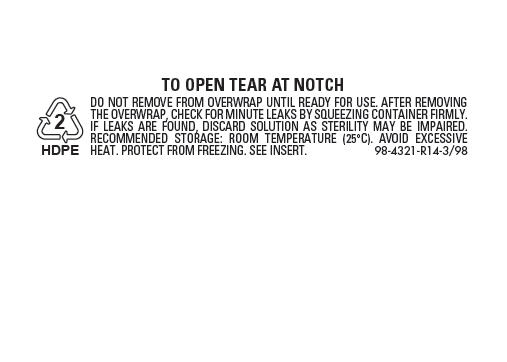
| LIDOCAINE HYDROCHLORIDE AND DEXTROSE
lidocaine hydrochloride injection, solution |
||||||||||||||||||||||||||||||||||||||||
|
||||||||||||||||||||||||||||||||||||||||
|
||||||||||||||||||||||||||||||||||||||||
|
||||||||||||||||||||||||||||||||||||||||
|
||||||||||||||||||||||||||||||||||||||||
|
||||||||||||||||||||||||||||||||||||||||
| LIDOCAINE HYDROCHLORIDE AND DEXTROSE
lidocaine hydrochloride injection, solution |
|||||||||||||||||||||||||
|
|||||||||||||||||||||||||
|
|||||||||||||||||||||||||
|
|||||||||||||||||||||||||
|
|||||||||||||||||||||||||
|
|||||||||||||||||||||||||
| Labeler - Hospira, Inc. (141588017) |
| Establishment | |||
| Name | Address | ID/FEI | Business Operations |
|---|---|---|---|
| Hospira, Inc. | 093132819 | ANALYSIS(0409-7931, 0409-7939) , LABEL(0409-7931, 0409-7939) , MANUFACTURE(0409-7931, 0409-7939) , PACK(0409-7931, 0409-7939) | |
| Establishment | |||
| Name | Address | ID/FEI | Business Operations |
|---|---|---|---|
| Hospira, Inc. | 827731089 | ANALYSIS(0409-7931, 0409-7939) | |

